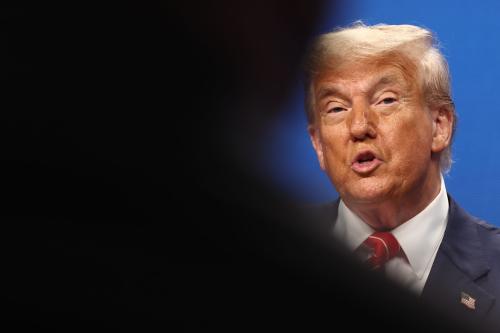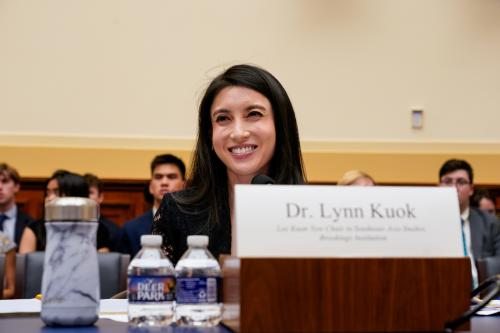In the midst of the global anti-terrorism effort, a different?though perhaps less noticed?angle on regional security may be taking shape in East Asia. In a series of meetings earlier this month, the ASEAN Plus Three leaders?grouping the 10 countries of the Association of Southeast Asian Nations, plus China, Japan, and South Korea?pushed ahead on their agenda of regional economic integration: China and ASEAN agreed to establish a free trade area and the 13 heads of state discussed a possible East Asia free trade area. Japan and Singapore had already concluded their negotiations for an Economic Partnership Agreement and other region-based free trade arrangements are in the works. Quietly, but steadily, momentum for East Asian regional economic integration is gaining ground. But rather than challenge U.S. leadership in the region, this trend shows promise both for the economic benefits it can bring and for its potential in building a more secure Asia Pacific.
Regional cooperation in East Asia, unlike the European Union (EU) or the North American Free Trade Agreement (NAFTA), has been slow in forming institutional frameworks despite a proliferation of fora for dialogue. It was hampered by such factors as competition and antagonism between Japan and China, disgruntlement and suspicion among some about U.S. regional leadership, and an absence of the kind of overwhelming geopolitical challenge that helped postwar Europe to cohere. These conditions, however, seem to be changing in the post-Sept. 11 global environment: the result may be both improved economic conditions and bolstered security as well. What conditions are leading to this fortuitous convergence?
First, trilateral relations among the United States, Japan, and China are improving simultaneously?an unusual situation?since the terrorist attacks. China was quick to side with the U.S., albeit with reservations, and Tokyo-Beijing tensions have substantially eased. Japan is to increase its role in rear-area support for the war on terrorism, a welcome move in Washington, and one that has not been opposed in Beijing. China accepted Japanese Prime Minister Koizumi Junichiro’s apology for Japanese aggression during World War II during his visit to Beijing in October, and the Chinese leadership has apparently shelved the history issue for the time being.
Whether the new trilateral dynamic can be sustained remains to be seen, but it could provide a useful opportunity for enhanced efforts toward integration and stability in Asia. When Japan-China relations are strained, establishing regional economic- and security-related frameworks proves difficult, if not impossible. And, as discussed below, stable U.S. relations with Japan and China are crucial to fostering the broad understanding within the U.S. that Asian integration can promote U.S. interests.
Second, structural reform and revitalization of Asian economies are becoming urgent against the backdrop of a deepening global recession, which became more severe after Sept. 11. East Asia must reduce its dependence on exports outside the region and base its economic growth more firmly on domestic or regional demand in order to stabilize the global, as well as the regional, economy. This requires external policy initiatives in addition to solving domestic problems such as deregulation or clearing up bad debt. To stimulate regional demand, the elimination of barriers to cross-border movement of corporate resources will be critical, thereby integrating long-fragmented regional markets and, in turn, enhancing the profitability of business activities to serve regional demand.
Third, China’s rapid growth and steady economic integration in the region aroused Asia’s interest in regional frameworks even before the terrorist attacks. On one hand, China’s neighbors are concerned about the “hollowing out” of their industries; on the other hand, they are eager for a slice of the ever-growing Chinese economic pie. These concerns and interests are growing as exports to other regions are radically reduced in the current global recession. Concerns over China’s burgeoning military capacity have further strengthened the case for having China engaged in a stable interdependence where one’s prosperity is in the interest of others. Beijing is well aware of the “China threat”?both economic and military?that is felt by its neighbors and is making efforts, through its support for regional political and economic structures, to reduce regional anxieties about its strategic intentions.
How can Washington take advantage of these conditions to promote favorable outcomes on the economic and security fronts? Washington has a clear interest in helping East Asia become more mature and integrated. Engaging China in stable regional interdependence will help reduce regional tension and lighten America’s security burden in the region. Japan, if it becomes more open, embedded, and trusted in the region, can become a more effective U.S. ally in dealing with diverse threats in post-Cold War Asia.
For starters, Washington should not worry about being excluded from East Asia. As the world becomes increasingly globalized, regional economic integration in the form of the exclusionary blocs?such as those that existed prior to World War II?is simply not an option. Furthermore, the speed of change in the business environment is too rapid for the World Trade Organization or other multilateral organizations to keep pace. Rather, regional efforts will offer a critical complement to enhance the stability of the global system. Moreover, East Asia’s economic fate is highly dependent on the U.S. market?meaning that America’s influence in the region can only be strengthened by its active support of regional cooperation, regardless of U.S. membership.
With this kind of confidence toward East Asian regional integration, Washington can take several steps to promote its interests there. First, as interim measures, the U.S. can help the push to minimize the inevitable increase in cross-border transaction costs while enhancing effectiveness of precautionary measures. Washington should continue its efforts to promote much-needed economic restructuring, encourage entrepreneurship and rule of law, and provide effective economic assistance to countries threatened with political instability in the region.
Looking further ahead, the U.S. can support the various building blocks of regional integration that will ultimately form a more comprehensive and institutionalized framework for regional integration. U.S. encouragement for the Japan-South Korea free trade arrangement?a significant step forward for two of the world’s most important economies and U.S. allies who are also divided over painful historical memories?will give a significant push for this bilateral initiative. A Japan-South Korea agreement will be difficult as it will force Japan to restructure most of its uncompetitive industries. But the two countries can be creative in harmonizing various rules and in developing common interfaces to deal with remaining regulatory differences. The expected conclusion of the U.S.-Singapore free trade agreement in early 2002 is another encouraging sign of U.S. involvement in the region.
In supporting and contributing to this nascent trend of regional economic integration, Washington can help East Asia seize a rare opportunity to overcome its lingering security problems, just as it helped realize European reconciliation and integration after World War II. Asia is different from Europe in its diversity and geopolitical challenges. But stronger economic relations and integration have proven to be a welcome and promising path to stability. It is an enterprise well worth pursuing further.
The Brookings Institution is committed to quality, independence, and impact.
We are supported by a diverse array of funders. In line with our values and policies, each Brookings publication represents the sole views of its author(s).



Commentary
Op-edFocus on the Benefits, Not Threats, of Regional Economic Integration
November 16, 2001